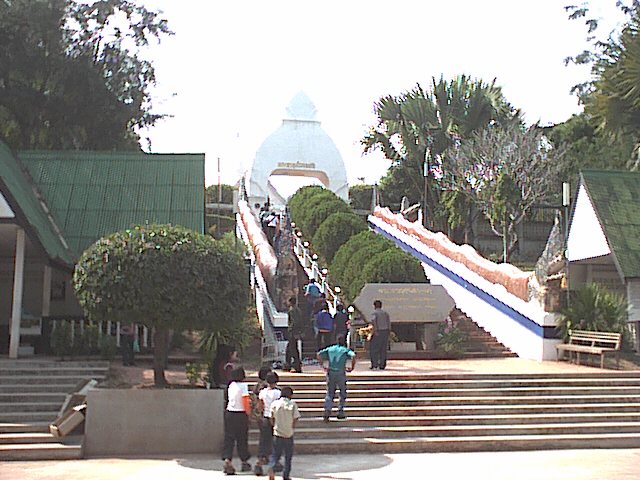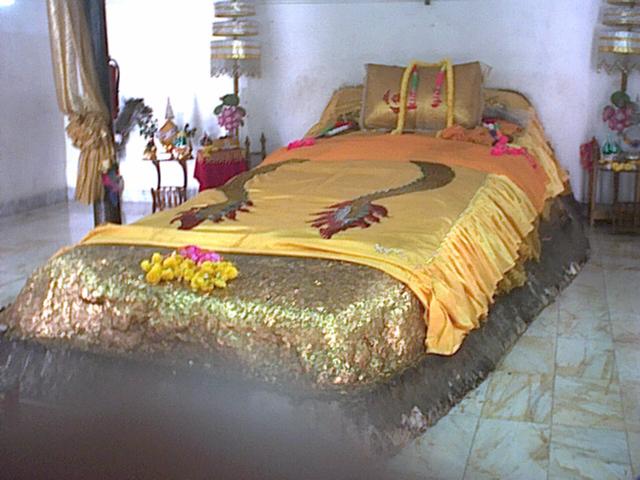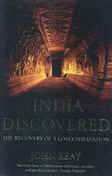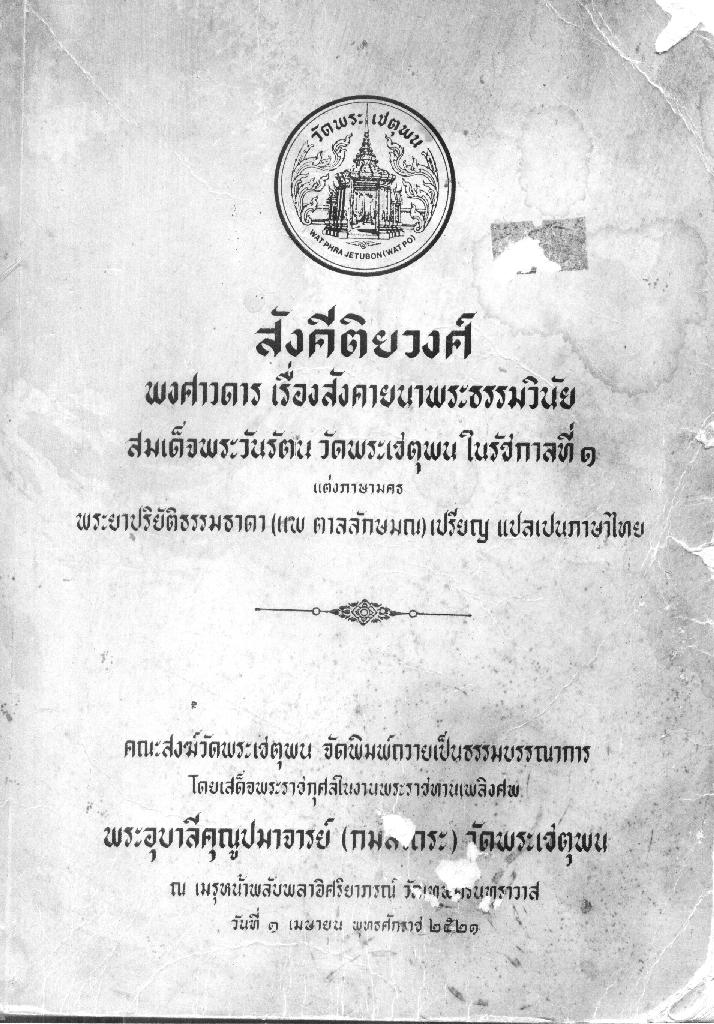|
|
DISTORTED INFORMATION ON THE BIRTHPLACE OF GOD PUTTHA (BUDDHA) BY BRITISH
ARCHEOLOGISTS
"History is what we know. If what we know is wrong, history is wrong."
This statement is probably true for the case of the
history of Buddhism!
"Two hundred years ago, India was seen as a place with little history and
less culture. Today it is revered for a notable prehistory, a
magnificent classical age and a cultural tradition unique in both character
and continuity. ...." wrote the HarperCollins Publishers on the back
cover complimenting
John Keay's excellent book on India Discovered: The Recovery of a Lost
Civilization.
The Thai God, Pout or Codom (Buddha or Gautama), as appears in a French
account had been worshipped in India for thousand years. William Chambers
who had first reported on the boulders temples of Mahabalipurum, read the
French account of Thailand and made the important identification of the Thai
god, known as Pout or Codom who had once been worshipped in parts of India.
(Keay, pp.66-67)
But how was India turned to be a cradle of world culture and how Thai
god or Buddhism was drag-netted from its authentic origin in the
Suwannabhumi (where Thailand, Laos, Cambodia, Burma and Raman are
presently located)? Why was there no one aware of the existed history of
Buddhism and its ancient scripture available in those countries?
The answers were found from various documents remarkably synthesized and
presented by John Keay.
In
“The Legacy of Pout”, Keay mentioned the work of Captain E. Fell who, after
frequent visits to Sanchi (Sanji), described the marvelous stone carving depicting
various aspects of stone temples, erected pillars, well designed and carved
to portray stories of certain religion related ceremonies and convinced that
Sanchi was Buddhist.
To
this, Keay observed “…if Sanchi was Buddhist though, where were the
Buddha’s followers today?”
“The answer was almost everywhere,” Keay asserted, “Ladakh, Nepal, Tibet,
China, Burma, Thailand and Ceylon-except India. Buddhism engulfed the
subcontinent, but in India it was unknown.”
Yes, why Buddhism was not practiced in India? The answer? Buddhism had never
started in India because the country was predominantly under Hinduism.
Thanks to Artist William Simpson’s work in water color (1862), our analysis
of the stupas at Sanchi revealed clearly that the stupas were in no way
Buddhist. Focusing at the sculpted reliefs coving their gateways, there was
at least one naked lady. If they were Buddhist, such naked or nude portrays
of male of female would not be permitted. The stupas at Scanchi were
definitely not Buddhist.
Thanks also to Artist J. C. M (1814) depicting in water color the
ruin Brahmin temple of Boddh Gaya which was identified Buddhist by a British
archeologist. Comparing the original temple and the present one, there are
many alterations and modifications to make the Brahmin temples the Buddhist.
Then, who were responsible for informing and misleading people in the whole
world to believe that Buddhism originated in India?
During 1812-1867, five British archeologists, namely James Prinsep, Brian
H. Hodgson, Francis Buchanan, a Mr. George Turnour (Ceylon), and Alexander
Cunningham (a son of famous poet- Allan Cunningham), revealed the series of
information misleading themselves to the conclusion that Buddhism originated
in Hindustan (present India).
Among these archeologists, Alexander Cunningham had the strongest commitment
to trace the history of Buddhism. During 1834-54, Cunningham excavated many
places in Sarnath, Bhilsa, Sanji. Probably unaware of the fact that the
authentic history of Buddhism had already existed in Thailand and its
neighboring countries, Cunningham managed to rewrite the history of
Buddhism basing on a few Buddhist artifacts found during excavation. He was
also partially credited for compiling the history of India and dubbed as the
“old campaigner.” For his archeological works, he was knighted in 1887.

Fig 1 Pratat Sri Song Rak: Buddha's Birth
Place in Loey
|
For more than thousand years, people in Thailand and Laos believe that their
Lord Buddha was born in the present land known as Suwannabhumi
(mentioned in the Tripitaka as "Chompoo Dwip-meaning the land of Chompoo
trees).
In Thailand, Laos, and Burma, there are ten thousands of Buddhist
artifacts, temples, chedi, Buddha's foot prints, images, laser-like
imprint of Buddha's shadows on cave walls, ancient scripture describing the
presence of Lord Buddha in many ancient cities and towns, and relics of
Lord Buddha and of his disciples.
The news of the discovery that Buddha was born in India stormed across the
earth like tidal waves because of the British influence in their colonies
spreading all over the world. It reached
Thailand in the reign of King Rama IV (King Mongkut)
who had been in the monkhood for many years before his succession to the
throne. King Mongkut had a strong belief that the Buddha was born in
Suwannabhumi. But at that time, there was no conclusion until 1867 (B.E
2410) when Cunningham wrote and spread the news about his reconstruction of
Buddhism history--just a year before King Mongkut’s death. Had the King
been living longer, there definitely must have been a protest from Thailand
against British archeologists’ claim.
Three years
later, a Dr. Bradley who set up the first printing shop in Thailand, gave a
concerted support to the British claims by declaring that Thai writing system
(alphabets and vowels) was derived from India. Dr. Bradley
should have known that Thai systems of writing, Lai Sue Thai (Thai
alphabets-ลายสือไทย) and Lai Sue Khom (Khom alphabets-ลายขอมไทย), were originated 6,750
years ago by Khun Sue Thai and his brother Khun Khom Thai! That is about two thousand
years before the Sumerian.
Instead of trying to uphold Thailand’s own precious heritage and protest
against this world class distortion, no single Thai bold enough to openly
take any stand to counter attack the claims. At least three prominent, high
ranking figures, two senior monks and one official, accepted the British’s
theories. To the contrary, in the course of times, they advocated the new
Buddhism history and spread it through out Siam. The terms used in Thailand
such as Yonok, Milukha etc. were claimed to be derived from Greek’s. After
B.E. 2440 (1897AD), the authentic version, Sankitiyawong, written by
the Venerable Pra Wanarat of Wat Po in BE.2332 (1789 AD), was no longer in
use by the Thai Sanka to show how civilized Thai monks were for not
believing in Ajinteya stage or supernatural phenomena as mentioned in
the Sankitiyawong.
Around B.E.
2440s or 1890s, the reactions and protests to the high ranking monks, ignited and begun
by groups of Buddhist monks, were peacefully demonstrated. For example, a
Venerable Pra Dhammachedi (Pan), a senior monk of Wat Mahanaparam Temple in
Bangkok, wrote a book
protesting the Thai Sangka for accepting the fact that
the Lord Buddha was born in Hindustan, the belief presented by a group of
eight Indians from Kasi who were accused by the monk for taking back to
India the Buddhist scripture, teaching documents, and glossary. They
returned to Thailand with the map of India marked with names of cities,
rivers, mountains as appeared in the Buddhist Tripitaka.
Buddhist people were so upset about this distortion of the world history.
"…Old people were so mad to the accusation that the Buddha was Indian."
recalled Professor Dr. Preedee Kasemsap, a former President of Thammasart
University recalled.
Three groups
of academic and researchers, ignited by the book and long doubts about the
Lord Buddha being born Indian, began their studies on the original
birthplace and whereabouts of the Lord Buddha during his 80 years until he
entered nirvana in 543 BC.

Fig 2 Pra Taen Dong Rang: The Buddha's Death Place where the Lord Buddha passed away to
enter Nirvana 543 BC.
Province, Northeastern Thailand |

Fig. 3 Cover of the book by John Keay (2001).
This book, probably without the author's awareness, provides useful
information on the works of British archeologists which caused the whole
world to believe that Buddhism originated in India.

Fig
4
Cover of Sankitiyawong, the authentic History of Buddhism
written in 1789 nearly 80 years before Cunningham’s reconstructed and
distorted it.
Express your views, click here: 

Read special articles contributed by our members:


Reasons
in brief why we believe the Buddha Birthplace is in Thailand. Please click

The search for the
truth has already begun! We are positive that Buddhism took place in Suwannabhumi,
not in India. We'd like to invite all interested parties to view some
observations and artifacts and help provide us some technical supports to carry out the
studies so that someday, a decade or a century, in the future the truth
shall be revealed!
           
Summary of Research
Findings:
 Thai
Thai
 English English |